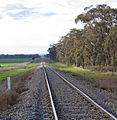Temora Railway Station
The station had a traditional role as a transfer point for passenger services to Hillston, Lake Cargelligo, Rankin Springs, Burcher and Naradhan, most of which were withdrawn in the late 1970s. The station is not presently served by passenger services however remains an important signalling facility.
History
The railway line from Cootamundra came through to Temora, opening on 1 September 1893. The station is located 489.29 kilometres (304.03 mi) from Sydney Central; at an altitude of 291.9 metres (958 ft) AHD; being measurements at the rail, centre of the platform. The railway station took its name from the local property and town, named by Mr. J. D. Macansh in 1848 after a castle called "Temora" in one of Ossian's epic poems.
One item within the yard is the bagged wheat shed, later to become the barley shed. This was built in 1905 to hold 30,000 bags of wheat, and was extended in 1907. Its erection was largely due to Mr. J. J. Donnelly, a prominent grain mechant of the Temora district, who came to Temora in 1893, and in 1904 had begun exporting grain to London. This trade he carried on successfully, included sending 202,000 bags of Temora wheat to London in 1907. The Gillespie and Pardey's Mill siding was opened in 1909. The line was interlocked on 4 March 1915.
The Shell Siding came into operation in 1926.
A F-type level crossing lights were established on the Junee Road crossing on 9 January 1969.
Temora's new youth space was officially opened on 9 December 2015 by Member for Cootamundra, Katrina Hodgkinson. The hub is part of the extensive redevelopment of the heritage-listed railway station. Council received a NSW Government ClubGRANTS funding of $110,993 towards the new room, and acknowledges the support and assistance of the NSW Heritage Division (OEH), Transport NSW and the John Holland Group. The hub is the base for the Shire's Youth Team and a venue for events and programmes. The official opening of the overall redevelopment of the station will be celebrated next March, with a visiting steam train and other activities. Dulux was reported to have donated 100 litres (22 imp gal; 26 US gal) of paint in 2015 to the repainting. The station was refurbished with a new community/kids centre/cafe area in the former refreshment room, while the railway station area became a rail museum with historical photos and stories on display.
Description
The complex includes a type 4, third class standard roadside brick station building, completed in 1893; a brick structure, with a reversed curved verandah across the eastern facade with a corrugated iron, single hipped roof, and a verandah extending over the platform area; a refreshment room made of brick, as an initial island/side building, completed in 1912 and extended 1914; a type 3 signal box with a timber skillion roof, completed in 1915; and a footbridge, completed in 1913.
Heritage listing
As at 9 December 2015, Temora is a major station complex with a significant third class station building of substantial scale, well detailed in excellent original condition. It is one of the best surviving third class buildings in the State. The support buildings on the platform support the main building. The station retains an excellent street side verandah. The locomotive complex is a good example of a distant country facility with a rare surviving Institute building and office.
The Temora railway station was listed on the New South Wales State Heritage Register on 2 April 1999 having satisfied the following criteria.
The place possesses uncommon, rare or endangered aspects of the cultural or natural history of New South Wales.
This item is assessed as historically rare. This item is assessed as arch. rare. This item is assessed as socially rare.
Gallery
-
railway line near Temora
-
railway line near Temora
-
Lake Cargelligo Water Tower & Turntable
-
Temora Sub Terminal
-
Temora Railway Station
See also
References
- ^ "Temora Railway Station group". New South Wales State Heritage Register. Department of Planning & Environment. H01265. Retrieved 2 June 2018.
 Text is licensed by State of New South Wales (Department of Planning and Environment) under CC BY 4.0 licence.
Text is licensed by State of New South Wales (Department of Planning and Environment) under CC BY 4.0 licence.
- ^ "Temora station". NSWrail.net. n.d. Retrieved 11 August 2009.
- ^ "Railway Station Platform & Buildings". New South Wales Heritage Database. Office of Environment & Heritage. Retrieved 4 November 2018.
- ^ Temora Independent. 1 December 2015. p.3
Bibliography
- David Scobie Architects Pty Ltd (2003). Temora Shire Community based Heritage Study.
- State Rail Authority (1997). State Rail Authority Section 170 Register.
Attribution
![]() This Wikipedia article contains material from Temora Railway Station group, entry number 01265 in the New South Wales State Heritage Register published by the State of New South Wales (Department of Planning and Environment) 2018 under CC-BY 4.0 licence, accessed on 2 June 2018.
This Wikipedia article contains material from Temora Railway Station group, entry number 01265 in the New South Wales State Heritage Register published by the State of New South Wales (Department of Planning and Environment) 2018 under CC-BY 4.0 licence, accessed on 2 June 2018.
External links
- "Adaptive Reuse – Temora Railway Station". National Trust of Australia. n.d.
- "TEMORA STATION REOPENING AND RESTORATION PROJECT COMPLETED". Temora Railway Station. 4 April 2016.
| Preceding station | Former services | Following station | ||
|---|---|---|---|---|
| Sproules Lagoon towards Lake Cargelligo
|
Lake Cargelligo Line | Combaning towards Cootamundra
| ||
| Pucawan towards Roto
|
Temora–Roto Line | Terminus | ||





